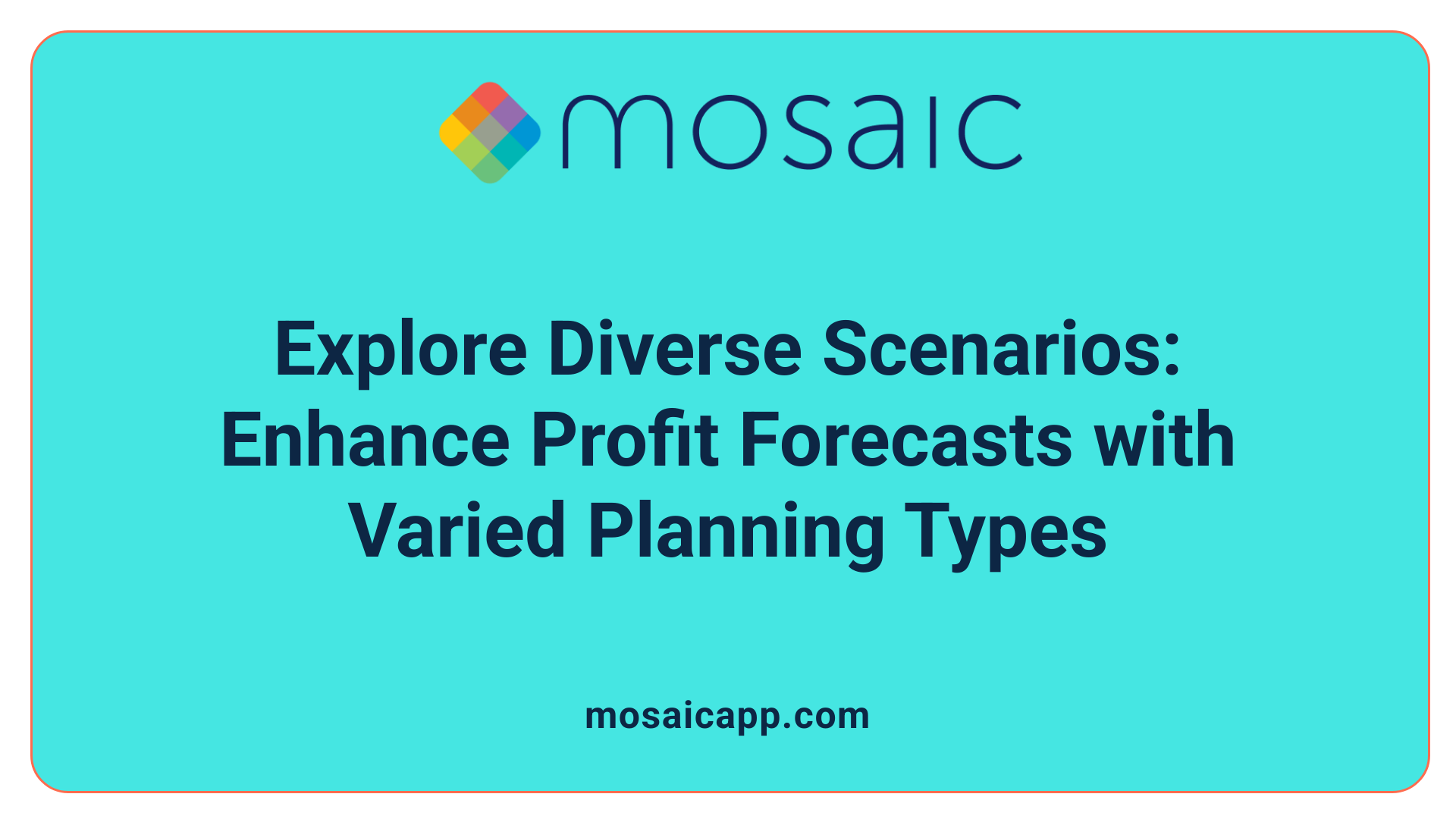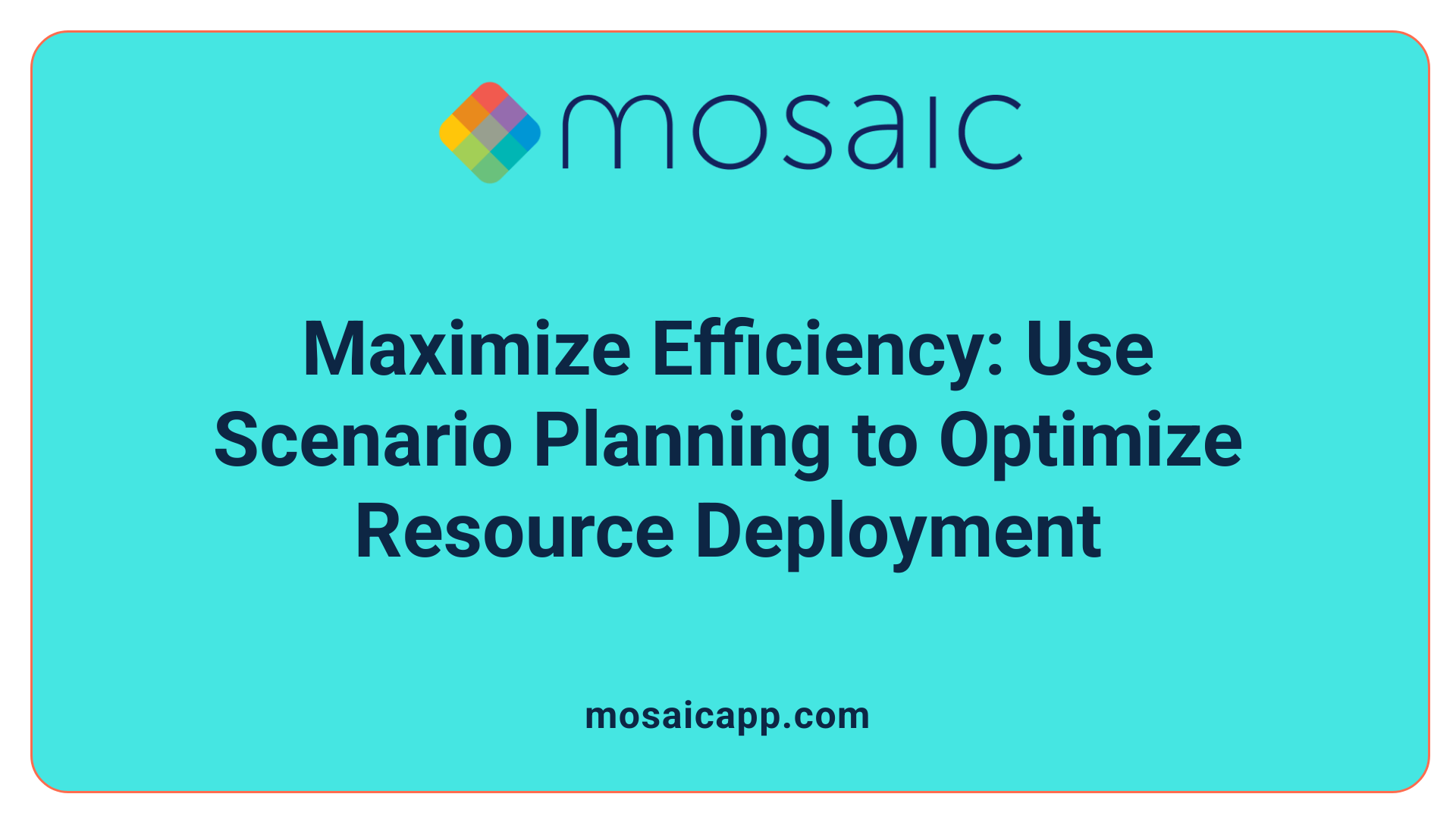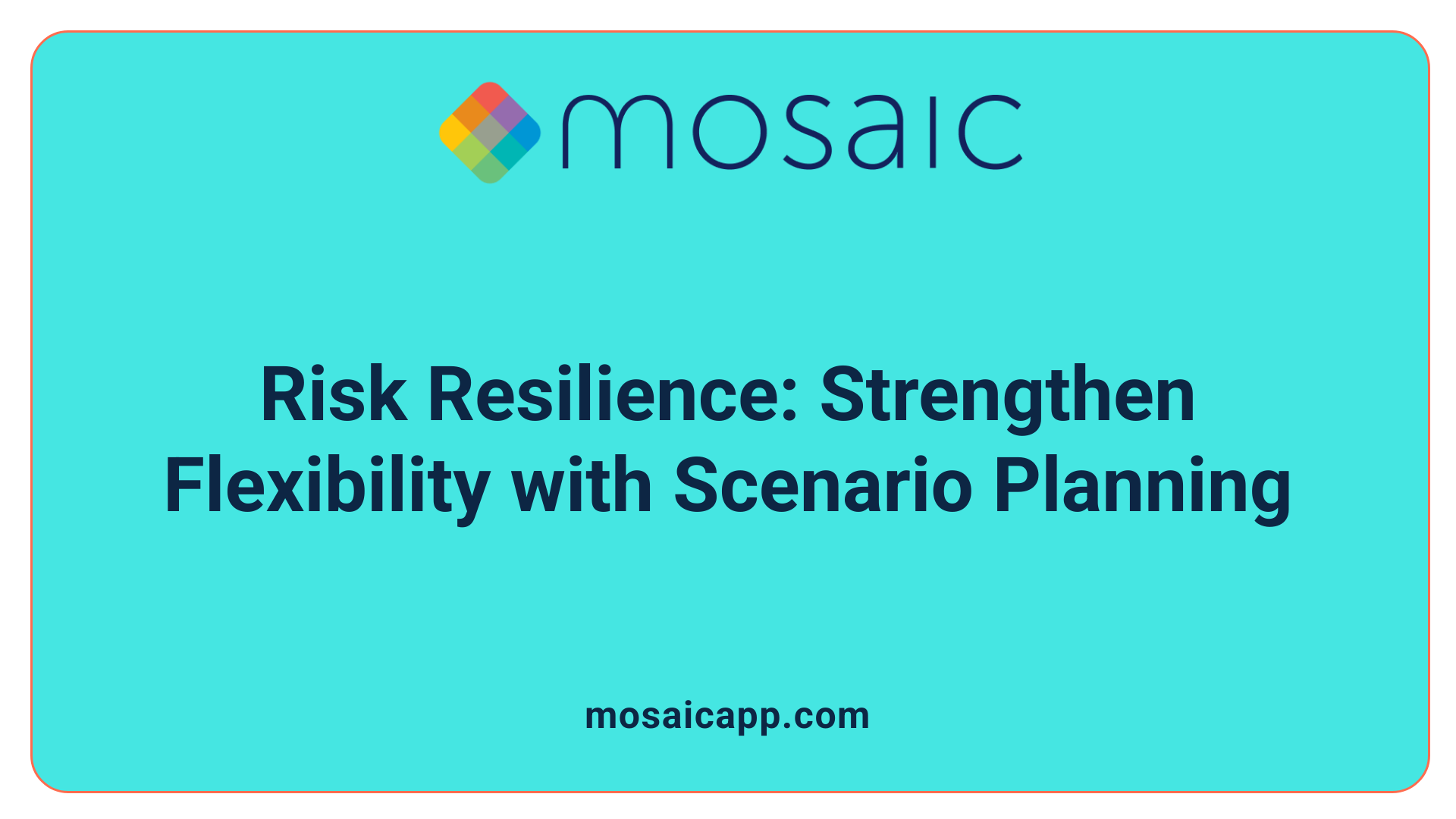Understanding the Power of Scenario Planning in Business Strategy
In an era marked by rapid change and uncertainty, firms face the daunting challenge of predicting their future profits with limited visibility into market dynamics and internal factors. Scenario planning emerges as a vital strategic tool enabling decision-makers to anticipate a range of possible futures, simulate responses, and optimize resource use. This article explores how scenario planning empowers organizations to refine project and resource management, enhance financial forecasting, and ultimately predict and protect future profits.
What Is Scenario Planning and Why It Matters for Profit Forecasting
What is scenario planning?
Scenario planning is a strategic method used to create flexible long-term plans by exploring multiple possible futures. Rather than attempting to predict a single outcome, it helps organizations prepare for a range of potential environments and uncertainties. By building various plausible future scenarios—including best-case, worst-case, and most-likely outcomes—decision-makers can assess how different factors might impact their organization.
Why is scenario planning important for understanding future uncertainties?
The purpose of scenario planning is to provide a structured way to identify and analyze future uncertainties that affect business decisions. It helps organizations:
- Anticipate potential risks and opportunities
- Test the impact of external drivers like economic shifts, technology changes, or competitive pressures
- Improve resource allocation by preparing for diverse outcomes
- Enhance resilience and adaptability in uncertain market conditions
- Support financial modeling such as budgeting and risk management
Through this process, organizations gain foresight that improves strategic alignment and forecasting accuracy.
How does scenario planning differ from business continuity planning?
Though related, scenario planning is distinct from business continuity planning. Whereas business continuity focuses on preparing for specific disasters or emergencies to ensure operational survival, scenario planning takes a broader, long-term view. It explores multiple possible futures in terms of revenue and market dynamics, enabling organizations to develop flexible strategies that address a variety of potential paths rather than reacting to singular events.
In summary, scenario planning offers organizations a comprehensive yet manageable framework to proactively address future uncertainty, supporting more informed decisions and better profit forecasting.
How Scenario Planning Integrates with Resource Management in Project Planning
What is resource management in project management?
Resource management in project management involves estimating, acquiring, allocating, scheduling, and monitoring resources such as personnel, equipment, materials, and data throughout the project lifecycle. The goal is to optimize their use, minimize costs, and maintain balanced workloads to ensure project success.
Role of scenario planning in analyzing resource needs and uncertainties
Scenario planning helps identify various potential future conditions that could impact resource availability and demands. By modeling best-case, worst-case, and most likely scenarios, project managers can anticipate shifts in resource needs — for example, changes in personnel requirements during demand surges or disruptions in material supplies.
Enhancing resource optimization and deployment
Using scenario planning, organizations can simulate different project outcomes based on changing resource capacities, schedules, and priorities. This allows teams to optimize resource allocation and deployment efficiently, ensuring that resources are neither underutilized nor overstretched under varying circumstances.
Link between scenario planning and resource management
Scenario planning ties closely with resource management by providing the foresight needed to adjust resources proactively rather than reactively. It enables continuous adaptation through "what-if" analyses, helping project managers prepare contingency plans and avoid bottlenecks caused by resource shortages or overcommitments.
Overview of resource management in project management
Ultimately, integrating scenario planning enhances project agility and resilience. Leaders can make informed decisions with real-time visibility into resource status and potential future conditions, supported by scenario planning tools. This synergy facilitates risk mitigation, strategic alignment, and improved resource utilization across the project's lifespan.
Key Components of Resource Management Planning Enhanced by Scenario Analysis
Identifying and Forecasting Resource Needs
Resource management planning starts with accurately identifying the necessary resources for a project or operation. Scenario analysis enhances this by allowing organizations to forecast resource demands under various future conditions, such as low, medium, or high demand scenarios. This process helps anticipate fluctuations and prepare for different supply or personnel requirements.
Allocation, Responsibilities, and Resource Calendars
Clear allocation of resources involves assigning responsibilities to specific individuals or teams and establishing resource calendars that define availability windows. Scenario planning supports this by simulating how resource availability or conflicts might shift under different future scenarios, enabling better scheduling and workload management.
Incorporating Constraints, Assumptions, and Risk Evaluations
Effective resource management requires acknowledging constraints such as budget limits, regulatory requirements, or operational bottlenecks. Integrating assumptions about external drivers and internal factors through scenario planning allows for more informed risk evaluation. Organizations can better anticipate challenges and design contingency responses tailored to each scenario's implications.
Supporting Tools and Matrices
Utilizing tools like Resource Breakdown Structures (RBS) to detail component resources, and Responsibility Assignment Matrices (RAM) to clarify roles, streamlines resource management. Scenario planning benefits from such frameworks by providing structured data inputs and facilitating "what-if" analyses. Software platforms that provide real-time operational data and modeling capabilities further aid in dynamically adjusting resource plans according to scenario outcomes.
Scenario analysis, when integrated into resource management, transforms planning into a proactive, flexible process that adjusts to uncertainty while optimizing resource use.
| Component | Description | Scenario Planning Contribution |
|---|---|---|
| Resource Identification | Forecasting necessary resources | Anticipates fluctuations through multiple demand scenarios |
| Allocation & Responsibilities | Assigning roles and creating resource calendars | Simulates impacts on availability and workload under varied conditions |
| Constraints & Risk Evaluation | Analyzing limitations and uncertainties | Incorporates assumptions and external drivers to assess risks |
| Tools & Matrices | Utilizing RBS, RAM, and software | Facilitates structured analysis and dynamic scenario modeling |
The Strategic Value of Scenario Planning in Project and Financial Decision-Making

How Does Scenario Planning Support Strategic Decisions in Market Expansion and R&D?
Scenario planning plays a vital role in high-impact decisions like market expansion, research and development (R&D) investments, and mergers. By simulating best-case, worst-case, and most-likely future scenarios, organizations gain insights into potential opportunities and threats. This foresight helps leaders evaluate how different strategic paths could perform under varying market conditions and external factors, enabling better risk mitigation and more informed commitment of resources.
How Is Scenario Planning Used in Financial Impact Modeling and Budgeting?
Organizations integrate scenario planning into their financial forecasting and budgeting processes to anticipate how changes in demand, costs, or economic shifts affect their financial health. By incorporating "what-if" analyses—such as demand surges or supply chain disruptions—financial teams can model profit fluctuations across various plausible futures. This aids in crafting realistic budgets and adapting expenditure plans to maintain financial resilience.
What Role Does Scenario Planning Have in Risk Management and Contingency Planning?
Scenario planning enhances risk management by systematically exploring a range of uncertainties and their implications. This structured approach allows companies to develop contingency plans tailored to potential future risks. By preparing responses for low, medium, and high impact scenarios, organizations can act swiftly and confidently when disruptions occur, safeguarding ongoing operations and strategic initiatives.
How Does Scenario Planning Improve Forecasting of Profit Fluctuations?
By projecting different future states—affected by external factors like regulation changes, technological developments, or economic trends—scenario planning provides a nuanced understanding of how profits might vary. It enables organizations to anticipate revenue volatility and plan accordingly, ensuring that resources are allocated efficiently and that strategic adjustments can be made proactively.
| Strategic Area | Scenario Planning Application | Benefits to Organizations |
|---|---|---|
| Market Expansion & Mergers | Modeling different market and competitive scenarios | Reduced uncertainty, better resource allocation |
| R&D Investments | Evaluating potential technological and market shifts | Enhanced innovation strategies and risk mitigation |
| Financial Impact Modeling | "What-if" financial analyses based on demand and cost changes | Accurate budgeting and improved financial resilience |
| Risk and Contingency Planning | Developing response plans for different risk scenarios | Preparedness and quicker recovery from disruptions |
Overall, integrating scenario planning into both project and financial decision-making empowers organizations to navigate uncertainty with greater agility, aligning resources and strategies for sustainable growth and resilience.
Different Types of Scenario Planning and Their Roles in Profit Forecasting

What Are the Different Types of Scenario Planning?
Scenario planning encompasses several distinct types, each serving unique roles to enrich strategic foresight and profit forecasting:
- Quantitative Scenarios: These involve financial models that simulate best- and worst-case outcomes, offering numerical forecasts essential for budgeting and risk management.
- Operational Scenarios: Focused on immediate event impacts, these scenarios help organizations anticipate short-term operational challenges and resource needs.
- Normative Scenarios: These describe desired future states, guiding strategic alignment and long-term goal setting.
- Strategic Management Scenarios: Broad in scope, these analyze industry trends and economic outlooks, helping organizations prepare for external influences over extended horizons.
How Does Each Type Contribute to a Comprehensive Future Outlook?
Each scenario type plays a critical role in building a robust picture of potential futures:
- Quantitative approaches quantify financial risks and opportunities, facilitating informed profit forecasts.
- Operational scenarios allow for tactical adjustments to maintain efficiency and flexibility in resource deployment.
- Normative scenarios help teams envision and strategize towards aspirational targets.
- Strategic Management scenarios provide context for external uncertainties, like market shifts and regulatory changes, crucial for long-term planning.
Selecting the Right Scenario Types for Organizational Needs
Choosing appropriate scenario types depends on the organization's goals and industry context:
- For financial service firms, quantitative scenarios dominate to manage revenue risks.
- Manufacturing might rely on operational scenarios to handle supply chain uncertainties.
- Non-profits could use normative scenarios to plan impact-driven missions.
- Businesses facing dynamic markets benefit from strategic management scenarios to anticipate economic changes.
Leveraging a combination tailored to an organization's unique environment ensures comprehensive planning, enhancing profit forecast accuracy and strategic agility.
Tools and Technology Supporting Scenario Planning and Resource Management
Use of ERP Platforms Like NetSuite ERP to Integrate Real-Time Data
Enterprise Resource Planning (ERP) platforms such as NetSuite ERP play a crucial role in scenario planning by offering real-time visibility into both operational and financial data. These platforms allow decision-makers to conduct "what-if" analyses by modeling scenarios such as demand surges or supply chain disruptions using current and historical data. This integration ensures that planning is grounded in reliable, up-to-date information, which enhances responsiveness and accuracy.
Financial Software and Risk Management Tools
Financial management software like Cube supports scenario planning through detailed financial modeling, enabling organizations to simulate best- and worst-case financial outcomes. Complemented by risk management tools, these solutions help forecast budgeting needs, assess risk exposure, and prepare contingency plans. Together, they provide a comprehensive framework for managing uncertainty in financial health.
Automation Tools Such as monday.com and Kelloo
Automation and collaboration platforms like monday.com enhance scenario planning by improving monitoring, real-time tracking, and alerting for scenario indicators. This facilitates adaptive strategy adjustments as conditions evolve. Meanwhile, specialized tools like Kelloo focus on resource and project management by allowing the creation of multiple scenarios that model resource capacity changes, schedule adjustments, and project prioritization shifts – essential for optimizing resource deployment.
Benefits of Scenario Planning Software in Modeling Resource Capacity and Project Priorities
Scenario planning software offers significant benefits including agility, risk mitigation, and strategic alignment. By enabling organizations to simulate different future conditions, these tools improve forecasting accuracy and resource management. They help organizations anticipate project delays, shift priorities, and adjust scopes effectively, which is critical in dynamic environments.
Common Techniques and Tools in Resource Management Planning
In resource management, common tools include Gantt charts and resource histograms to visualize workloads and timelines. Techniques such as capacity planning and utilization tracking assist in ensuring optimal resource allocation. Specialized software like Motion and ProjectManager provide real-time monitoring and workload balancing, enhancing proactive resource management.
| Tool/Platform | Primary Function | Key Benefit |
|---|---|---|
| NetSuite ERP | Real-time operational and financial data | Enables accurate "what-if" scenario modeling |
| Cube | Financial impact modeling | Supports budgeting and risk assessment |
| monday.com | Automation and collaboration | Improves monitoring and adaptive strategy |
| Kelloo | Resource and project management | Models capacity and prioritization scenarios |
| Gantt Charts | Project scheduling visualization | Facilitates timeline and workload planning |
| Motion & ProjectManager | Real-time resource monitoring | Enhances workload balancing and utilization |
Implementing Scenario Planning: The Phased Approach to Predicting Profits
Identifying Key Issues and Uncertainties
The first phase in scenario planning involves thoroughly identifying and analyzing critical issues and uncertainties that could impact future outcomes. These include economic shifts, regulatory changes, technological advancements, and market dynamics. Pinpointing these drivers allows teams to focus on the most impactful factors shaping potential futures.
Scenario Development Using Structured Frameworks Like 2×2 Matrix
Once key uncertainties are outlined, organizations develop multiple scenarios to explore different futures. A structured approach such as the 2×2 matrix helps create 2-4 distinct plausible scenarios by crossing two axes of major uncertainties. This method simplifies complex variables into clear categories, such as best-case, worst-case, and most-likely scenarios, aiding in structured analysis.
Strategic Response, Action Planning, and Continuous Updates
After scenario development, organizations engage in strategic response planning. This involves assessing implications of each scenario and crafting responsive strategies robust across multiple futures. Continuous updating of scenarios is essential; regular monitoring of indicators ensures strategies remain relevant amid evolving conditions. This dynamic process fortifies organizational agility.
Involvement of Cross-Functional Teams
Effective scenario planning mandates assembling cross-functional teams combining finance, operations, marketing, and risk management. Diverse perspectives enrich assumptions and scenario validity while fostering collaboration and shared ownership of plans. Teams work together to gather reliable data, define clear assumptions, and develop focused, manageable scenarios, helping avoid complexity and analysis paralysis.
Best Practices and Challenges in Scenario Planning for Financial Forecasting
Defining Clear Assumptions and Limiting Scenarios to Avoid Paralysis
Successful scenario planning starts with establishing clear, realistic assumptions that underpin each scenario. Decision-makers should focus on limiting the number of scenarios—typically to three—to prevent analysis paralysis. These scenarios usually cover low, medium, and high possibilities, providing clarity without overwhelming stakeholders.
Focusing on Material Differences Between Scenarios
To maintain focus and effectiveness, it’s important to emphasize the material differences that distinguish each scenario. This approach helps organizations concentrate on meaningful variations in outcomes and responses, ensuring that scenario planning is targeted on significant factors influencing financial forecasting.
Continuous Monitoring and Scenario Updates
Scenario planning is a dynamic activity that requires ongoing monitoring of key indicators and assumptions. Regular updates ensure that scenarios remain relevant amid changing economic conditions, technological advances, and competitive landscapes. This continuous refinement improves the accuracy and usefulness of forecasts over time.
Challenges Including Complexity, Resource Intensity, and Assumption Sensitivity
Despite its advantages, scenario planning comes with challenges. The process can be complex and resource-intensive, requiring cross-functional teams and reliable data beyond typical financial information. High sensitivity to underlying assumptions may lead to misleading conclusions if not carefully managed. Furthermore, overemphasis on certain external factors or unforeseen events can disrupt planning efforts. Organizations must also be cautious of decision paralysis that results from too many scenarios or overly complicated models, emphasizing the importance of simplicity and clarity in the process.
Employing these best practices while acknowledging and mitigating challenges can significantly enhance the value of scenario planning, especially in financial forecasting contexts where uncertainty and volatility are common.
Enhancing Project Outcomes through Effective Resource Management Powered by Scenario Planning

Benefits of optimal resource utilization
Optimal resource utilization ensures that personnel, equipment, and materials are allocated efficiently, preventing waste and lowering overall project costs. Scenario planning helps organizations anticipate changes in demand or project scope, enabling better preparation and resource deployment.
Reducing bottlenecks, overallocation, and delays
By modeling different scenarios such as shifts in project priorities or capacity constraints, organizations can identify potential bottlenecks or overallocated resources before they occur. This allows proactive resolution, minimizing delays and improving workflow continuity.
Real-time tracking and demand forecasting
Leveraging platforms like NetSuite ERP or specialized tools such as Kelloo facilitates real-time visibility into resource availability and project progress. Scenario planning enables "what-if" analyses by forecasting resource needs based on varying project demands, thus enhancing agility and decision-making.
Improving productivity and alignment with strategic goals
Resource management combined with scenario planning aligns project execution with organizational strategies. It fosters better prioritization, allowing teams to focus on high-impact activities with optimized resource support, thereby boosting productivity and strategic outcomes.
How can effective resource management improve project outcomes?
Effective resource management reduces waste, lowers costs, and prevents delays by optimizing personnel and assets. Real-time tracking and forecasting support better staffing and prioritization, leading to improved project control and success.
The Relation of Resource Management to Overall Project Management Planning
How does resource management relate to overall project management planning?
Resource management plays a vital role in project management planning by ensuring that the necessary personnel, equipment, and materials are not only available but are allocated effectively across project tasks. This coordination helps align resources directly with project schedules and scopes, enabling smooth progress and balanced workloads.
Efficient resource management supports key project goals related to timeline adherence, cost control, and quality standards. By planning resource deployment strategically, organizations avoid bottlenecks and reduce downtime, which directly influences the ability to meet deadlines and stay within budget. It also helps maintain quality by matching skillsets and capacities appropriately to specialized project activities.
Integration with project management software further enhances resource coordination by providing real-time visibility into availability and utilization. Tools such as Kelloo facilitate modeling of different resourcing scenarios, allowing project managers to adjust allocations dynamically in response to timeline shifts or priority changes. This seamless integration improves both planning accuracy and responsiveness.
Ultimately, aligning resource management with overall project management planning drives operational efficiency and profitability. It enables optimized resource use, minimizes waste and underutilization, and strengthens project delivery reliability. Organizations benefit from better forecasting, smarter contingency planning, and enhanced strategic alignment, resulting in improved project outcomes and financial performance.
Scenario Planning’s Role in Risk Mitigation and Strategic Flexibility

Mitigating risks through preparation for multiple futures
Scenario planning equips organizations to prepare for a range of potential future scenarios instead of relying on a single forecast. By creating multiple plausible outcomes—such as best-case, worst-case, and most likely futures—decision-makers can identify risks early and evaluate responses in advance. This proactive approach reduces vulnerability to unforeseen challenges, supporting risk mitigation and enhancing overall resilience.
Enhancing organizational foresight and adaptability
Through structured scenario development, organizations gain improved foresight to anticipate market fluctuations, technological shifts, and regulatory changes. Including diverse perspectives and cross-functional teams in the process broadens understanding of potential drivers and uncertainties. This fosters adaptability, enabling companies to adjust plans and resource allocation quickly as new information emerges or conditions evolve.
Supporting contingency planning and communication
Scenario planning strengthens contingency efforts by modeling realistic "what-if" situations that may impact projects, finances, or operations. It provides a clear framework for assessing implications of various scenarios, which improves communication across teams and leadership. A shared understanding of alternative futures encourages collaborative strategic alignment and informed decision-making.
Avoiding reactionary decision-making
Unlike reactive business continuity planning, scenario planning allows organizations to move beyond immediate crisis response. It emphasizes long-term strategic thinking, focusing on identifying early warning signs and developing ongoing adaptive strategies. This forward-looking process decreases the tendency to make hasty or uninformed decisions during disruptions.
Overall, scenario planning serves as a valuable tool for organizations to manage uncertainty, prepare for diverse outcomes, and maintain strategic flexibility in complex and dynamic environments.
Maintaining Agility with Integrated Scenario Planning (ISP)
What is Integrated Scenario Planning (ISP) and Why is it Important?
Integrated Scenario Planning (ISP) is a strategic method organizations use to stay agile amid changing environments. It involves creating and analyzing various plausible future scenarios based on potential events, enabling companies to anticipate risks and optimize response plans. Unlike traditional scenario planning, ISP emphasizes continuous adaptation, allowing organizations to remain resilient by preparing for multiple possible futures rather than relying on a single forecast.
What Leadership Roles Support Effective ISP?
A crucial element of ISP success is leadership, particularly the appointment of a Scenario Management Leader. This individual is responsible for overseeing the evaluation of risks and opportunities tied to each scenario. The leader guides the development of response strategies and ensures stakeholder coordination, keeping the organization aligned with its strategic goals while preparing for uncertainty.
What Are the Planning and Implementation Phases of ISP?
ISP consists of two core phases:
Planning Phase: Teams identify and model different scenarios by analyzing driving forces and uncertainties. This involves defining scenarios, assumptions, and potential impacts.
Implementation Phase: The organization monitors predefined trigger points or scenario indicators in real time to detect when adjustments or responses are needed. This ongoing surveillance ensures swift action as external and internal conditions evolve.
How Does Continuous Environmental Scanning Sustain Adaptability?
Sustaining ISP requires dynamic observation of both internal operations and external environments. By continuously scanning these factors, organizations can update their scenario plans and response strategies promptly. This persistent awareness supports flexibility, helping companies fine-tune their approaches and maintain strategic resilience in rapidly evolving markets.
Together, these elements help businesses harness ISP to respond proactively to uncertainty and enhance long-term performance.
Industry Applications and the Strategic Payoff of Scenario Planning

How Does Scenario Planning Cater to Different Industries?
Scenario planning is highly adaptable, allowing industries like technology, healthcare, manufacturing, non-profits, and financial services to customize their approach. Each sector tailors scenarios based on unique external drivers and internal challenges to better prepare for future uncertainties. For example, technology firms focus on navigating rapid technological changes and innovation cycles, while healthcare organizations plan for demographic shifts and evolving regulatory landscapes.
How Does Scenario Planning Help Navigate Industry-Specific Challenges?
In manufacturing, scenario planning addresses supply chain vulnerabilities and shifts in global trade policies. Non-profit organizations use it to anticipate funding fluctuations and evolving stakeholder demands. Financial services benefit by modeling economic shifts and regulatory impacts, helping them mitigate risks and maintain compliance. This targeted focus aids in proactively mitigating disruptions and preparing for future market dynamics.
How Does Scenario Planning Enhance Profit Predictability and Competitive Advantage?
By exploring multiple potential futures, organizations gain sector-specific insights that improve forecasting accuracy and financial impact modeling. This enables better budgeting, risk management, and resource allocation tailored to industry conditions. Scenario planning also reveals new opportunities and strategic pivots, creating competitive advantages while fostering long-term resilience against market uncertainties.
What Is the Strategic Payoff of Scenario Planning Across Industries?
Employing scenario planning cultivates organizational agility, aligning strategy with evolving external realities. It promotes informed decision-making by highlighting critical uncertainties and possible outcomes, enabling industries to optimize operations and investments. Ultimately, this strategic foresight supports sustainable growth, strengthens resilience, and helps establish a proactive posture in a rapidly changing global environment.
Achieving Profit Predictability Through Strategic Scenario Planning
Scenario planning stands as a transformative approach for firms aiming to predict future profits amid uncertainty. By integrating robust scenario analysis with resource management and project planning, organizations gain a comprehensive understanding of potential futures, enabling proactive, flexible decision-making. Leveraging advanced tools and following best practices, businesses not only improve forecasting accuracy but also enhance risk mitigation, adaptability, and strategic alignment. Encouraging cross-functional collaboration and continuous scenario updates ensures companies remain agile and prepared, laying a solid foundation for sustained profitability and competitive advantage.
References
- What Is Scenario Planning? Strategy, Steps, and Practical ...
- Scenario planning: strategies, techniques, & examples [2024]
- Scenario Planning Process: 5 Steps to Future-Proof Your ...
- Scenario planning in project management
- Scenario Planning - Oliver Wight Americas
- Scenario Planning: A Detailed Guide
- What is Resource Management and Why Is It Important?

